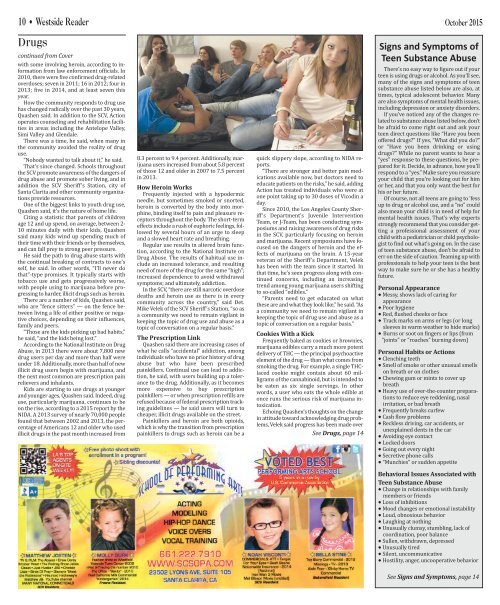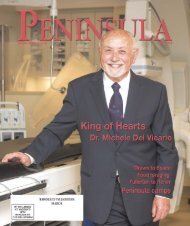Westside Reader October 2015
A newsmagazine covering the communities of Stevenson Ranch, Westridge, Castaic, Val Verde and Newhall Ranch, on the Westside of the Santa Clarita Valley.
A newsmagazine covering the communities of Stevenson Ranch, Westridge, Castaic, Val Verde and Newhall Ranch, on the Westside of the Santa Clarita Valley.
- No tags were found...
You also want an ePaper? Increase the reach of your titles
YUMPU automatically turns print PDFs into web optimized ePapers that Google loves.
10 • <strong>Westside</strong> <strong>Reader</strong><br />
<strong>October</strong> <strong>2015</strong><br />
Drugs<br />
continued from Cover<br />
with some involving heroin, according to information<br />
from law enforcement officials. In<br />
2010, there were five confirmed drug-related<br />
overdoses; seven in 2011; 16 in 2012; four in<br />
2013; five in 2014, and at least seven this<br />
year.<br />
How the community responds to drug use<br />
has changed radically over the past 30 years,<br />
Quashen said. In addition to the SCV, Action<br />
operates counseling and rehabilitation facilities<br />
in areas including the Antelope Valley,<br />
Simi Valley and Glendale.<br />
There was a time, he said, when many in<br />
the community avoided the reality of drug<br />
use.<br />
“Nobody wanted to talk about it,” he said.<br />
That’s since changed. Schools throughout<br />
the SCV promote awareness of the dangers of<br />
drug abuse and promote sober living, and in<br />
addition the SCV Sheriff’s Station, city of<br />
Santa Clarita and other community organizations<br />
provide resources.<br />
One of the biggest links to youth drug use,<br />
Quashen said, it’s the nature of home life.<br />
Citing a statistic that parents of children<br />
age 12 and up spend, on average, between 2-<br />
10 minutes daily with their kids, Quashen<br />
said many kids wind up spending much of<br />
their time with their friends or by themselves,<br />
and can fall prey to strong peer pressure.<br />
He said the path to drug abuse starts with<br />
the continual breaking of contracts to one’s<br />
self, he said. In other words, “I’ll never do<br />
that”-type promises. It typically starts with<br />
tobacco use and gets progressively worse,<br />
with people using to marijuana before progressing<br />
to harder, illicit drugs such as heroin.<br />
There are a number of kids, Quashen said,<br />
who are “fence sitters” — on the fence between<br />
living a life of either positive or negative<br />
choices, depending on their influences,<br />
family and peers.<br />
“Those are the kids picking up bad habits,”<br />
he said, “and the kids being lost.”<br />
According to the National Institute on Drug<br />
Abuse, in 2013 there were about 7,800 new<br />
drug users per day and more than half were<br />
under 18. Additionally, more than half of new<br />
illicit drug users begin with marijuana, and<br />
the next most common are prescription pain<br />
relievers and inhalants.<br />
Kids are starting to use drugs at younger<br />
and younger ages, Quashen said. Indeed, drug<br />
use, particularly marijuana, continues to be<br />
on the rise, according to a <strong>2015</strong> report by the<br />
NIDA. A 2013 survey of nearly 70,000 people<br />
found that between 2002 and 2013, the percentage<br />
of Americans 12 and older who used<br />
illicit drugs in the past month increased from<br />
8.3 percent to 9.4 percent. Additionally, marijuana<br />
users increased from about 5.8 percent<br />
of those 12 and older in 2007 to 7.5 percent<br />
in 2013.<br />
How Heroin Works<br />
Frequently injected with a hypodermic<br />
needle, but sometimes smoked or snorted,<br />
heroin is converted by the body into morphine,<br />
binding itself to pain and pleasure receptors<br />
throughout the body. The short-term<br />
effects include a rush of euphoric feelings, followed<br />
by several hours of an urge to sleep<br />
and a slowed heart rate and breathing.<br />
Regular use results in altered brain function,<br />
according to the National Institute on<br />
Drug Abuse. The results of habitual use include<br />
an increased tolerance, and resulting<br />
need of more of the drug for the same “high”;<br />
increased dependence to avoid withdrawal<br />
symptoms; and ultimately, addiction.<br />
In the SCV, “there are still narcotic overdose<br />
deaths and heroin use as there is in every<br />
community across the country,” said Det.<br />
Mike Velek of the SCV Sheriff’s Station, “so as<br />
a community we need to remain vigilant in<br />
keeping the topic of drug use and abuse as a<br />
topic of conversation on a regular basis.”<br />
The Prescription Link<br />
Quashen said there are increasing cases of<br />
what he calls “accidental” addiction, among<br />
individuals who have no prior history of drug<br />
abuse but who have been prescribed<br />
painkillers. Continual use can lead to addiction,<br />
he said, with users building up a tolerance<br />
to the drug. Additionally, as it becomes<br />
more expensive to buy prescription<br />
painkillers — or when prescription refills are<br />
refused because of federal prescription tracking<br />
guidelines — he said users will turn to<br />
cheaper, illicit drugs available on the street.<br />
Painkillers and heroin are both opioids,<br />
which is why the transition from prescription<br />
painkillers to drugs such as heroin can be a<br />
quick slippery slope, according to NIDA reports.<br />
“There are stronger and better pain medications<br />
available now, but doctors need to<br />
educate patients on the risks,” he said, adding<br />
Action has treated individuals who were at<br />
one point taking up to 30 doses of Vicodin a<br />
day.<br />
Since 2010, the Los Angeles County Sheriff’s<br />
Department’s Juvenile Intervention<br />
Team, or J-Team, has been conducting symposiums<br />
and raising awareness of drug risks<br />
in the SCV, particularly focusing on heroin<br />
and marijuana. Recent symposiums have focused<br />
on the dangers of heroin and the effects<br />
of marijuana on the brain. A 15-year<br />
veteran of the Sheriff’s Department, Velek<br />
has been with the team since it started. In<br />
that time, he’s seen progress along with continued<br />
concerns, including an increasing<br />
trend among young marijuana users shifting<br />
to so-called “edibles.”<br />
“Parents need to get educated on what<br />
these are and what they look like,” he said. “As<br />
a community we need to remain vigilant in<br />
keeping the topic of drug use and abuse as a<br />
topic of conversation on a regular basis.”<br />
Cookies With a Kick<br />
Frequently baked as cookies or brownies,<br />
marijuana edibles carry a much more potent<br />
delivery of THC — the principal psychoactive<br />
element of the drug — than what comes from<br />
smoking the drug. For example, a single THClaced<br />
cookie might contain about 60 milligrams<br />
of the cannabinoid, but is intended to<br />
be eaten as six single servings. In other<br />
words, a user who eats the whole edible at<br />
once runs the serious risk of marijuana intoxication.<br />
Echoing Quashen’s thoughts on the change<br />
in attitude toward acknowledging drug problems,<br />
Velek said progress has been made over<br />
See Drugs, page 14<br />
Signs and Symptoms of<br />
Teen Substance Abuse<br />
There’s no easy way to figure out if your<br />
teen is using drugs or alcohol. As you’ll see,<br />
many of the signs and symptoms of teen<br />
substance abuse listed below are also, at<br />
times, typical adolescent behavior. Many<br />
are also symptoms of mental health issues,<br />
including depression or anxiety disorders.<br />
If you’ve noticed any of the changes related<br />
to substance abuse listed below, don’t<br />
be afraid to come right out and ask your<br />
teen direct questions like “Have you been<br />
offered drugs?” If yes, “What did you do?”<br />
or “Have you been drinking or using<br />
drugs?” While no parent wants to hear a<br />
“yes” response to these questions, be prepared<br />
for it. Decide, in advance, how you’ll<br />
respond to a “yes.” Make sure you reassure<br />
your child that you’re looking out for him<br />
or her, and that you only want the best for<br />
his or her future.<br />
Of course, not all teens are going to ‘fess<br />
up to drug or alcohol use, and a “no” could<br />
also mean your child is in need of help for<br />
mental health issues. That’s why experts<br />
strongly recommend that you consider getting<br />
a professional assessment of your<br />
child with a pediatrician or child psychologist<br />
to find out what’s going on. In the case<br />
of teen substance abuse, don’t be afraid to<br />
err on the side of caution. Teaming up with<br />
professionals to help your teen is the best<br />
way to make sure he or she has a healthy<br />
future.<br />
Personal Appearance<br />
● Messy, shows lack of caring for<br />
appearance<br />
● Poor hygiene<br />
● Red, flushed cheeks or face<br />
● Track marks on arms or legs (or long<br />
sleeves in warm weather to hide marks)<br />
● Burns or soot on fingers or lips (from<br />
“joints” or “roaches” burning down)<br />
Personal Habits or Actions<br />
● Clenching teeth<br />
● Smell of smoke or other unusual smells<br />
on breath or on clothes<br />
● Chewing gum or mints to cover up<br />
breath<br />
● Heavy use of over-the-counter preparations<br />
to reduce eye reddening, nasal<br />
irritation, or bad breath<br />
● Frequently breaks curfew<br />
● Cash flow problems<br />
● Reckless driving, car accidents, or<br />
unexplained dents in the car<br />
● Avoiding eye contact<br />
● Locked doors<br />
● Going out every night<br />
● Secretive phone calls<br />
● “Munchies” or sudden appetite<br />
Behavioral Issues Associated with<br />
Teen Substance Abuse<br />
● Change in relationships with family<br />
members or friends<br />
● Loss of inhibitions<br />
● Mood changes or emotional instability<br />
● Loud, obnoxious behavior<br />
● Laughing at nothing<br />
● Unusually clumsy, stumbling, lack of<br />
coordination, poor balance<br />
● Sullen, withdrawn, depressed<br />
● Unusually tired<br />
● Silent, uncommunicative<br />
● Hostility, anger, uncooperative behavior<br />
See Signs and Symptoms, page 14

















